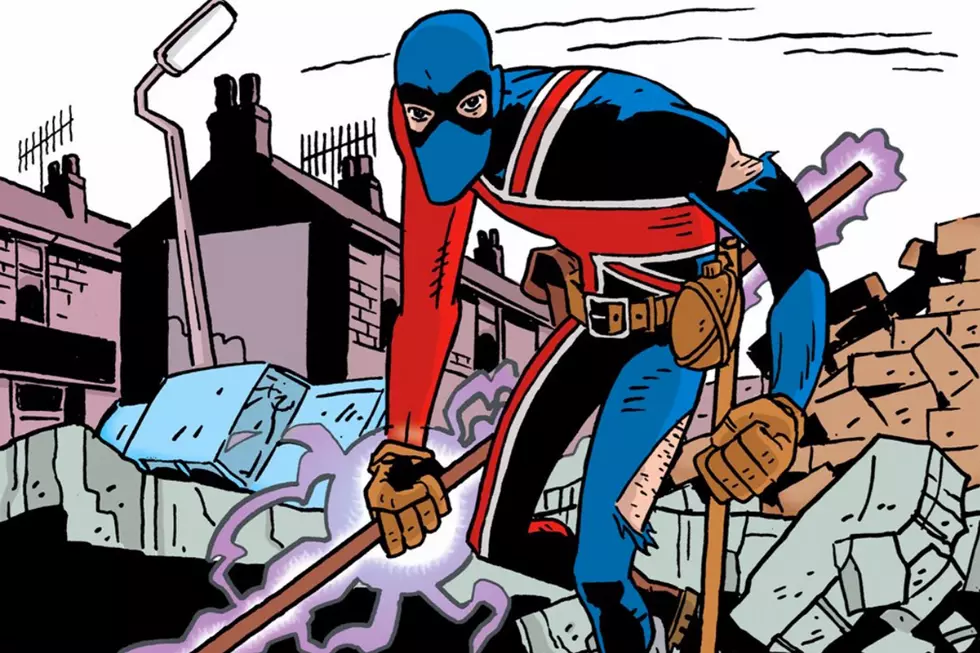
Celebrating the Ingenuity and Innovation of Paul Grist
Paul Grist was born on this day in 1960 in Sheffield, England. Among his earliest work are a story with a young Grant Morrison called St Swithin's Day, a Grendel story with Steven T. Seagle, and a Judge Dredd story with Robbie Morrison. In the '90s he wrote a Daily Bugle mini-series and a unique Spider-Man story for Marvel, and in the early 2000s, he contributed various stories to DC, including a Batman story drawn by Darwyn Cooke. He's also drawn stories for Doctor Who and Torchwood magazines.
But what we're really here to celebrate today are the works that Grist both wrote and drew, several of which he published himself via his own company, Dancing Elephant Press, in the '90s: Kane, Jack Staff, Burglar Bill, Mudman, Demon Nic.
Though these works may not be immediately familiar to casual readers, they stand as some of the finest works of pure and innovative storytelling in recent decades, firmly establishing Paul Grist as one of our finest living cartoonists.
From the first glance, a Paul Grist comic is instantly recognizable by its draftsmanship. Grist's style is deceptively simple, with its spare detail and stripped down figures. But as masters such as Alex Toth have shown, it takes more work to know what not to draw than to know what to draw. Grist is able to elicit texture and identifying detail with a minimal number of lines: a millimeter of ink here or there denotes wood, stone, or water in a way that a lesser artist would need a thousand hatchy lines to draw.
Perhaps an even stronger indicator of Grist's ability to strip down a drawing to its absolute essentials is his use of heavy spot blacks, especially noticeable in Kane, his somewhat noir-tinged police drama. With pages cloaked in black, an image is reduced to its absolute essence: what do we need to see to understand this scene, this character, to feel this emotion? Anything else is superfluous.
Such minimalist draftsmanship allows the focus to fall where it should, on one of Grist's other strong points: his lively and immediately engaging characters. Whether it's Detective Kane, the one good cop in New Eden; Tom-Tom the Robot Man, who (spoilers) is neither a robot nor a man; teen Owen Craig, who is unwittingly transformed into a being of mud; Becky Burdock, Vampire Reporter; or the Butler, a crime-fighting butler; Grist's characters are always clear, expressive, and immediately understandable from the first page on which they appear. The casts in his books are always so appealing, you will find yourself with a new favorite with each issue.
Despite the persistent (but false) legend that Jack Staff began life as a failed pitch for a Marvel Union Jack series, Grist's characters are often sly parodies that pull from much farther afield than just Marvel's stable of heroes.
Many pull from British comics (Tom-Tom is a reference to Robot Archie, not to Iron Man, for example), some from British television (Bramble and Son are dead ringers for Steptoe and Son, the British antecedent of Sanford and Son), and even from British writers (the obvious example being Morlan the Mystic, who more than a little resembles a certain bearded comics writer, but then there's ill-fated fantasy writer Iain M. Angel, who manages to not only be a reference to Iain M Banks, but also, via the power of anagram, Neil Gaiman). These cultural references, together with Grist's dry wit, make his comics almost quintessentially British.
Tight, expressive drawing and appealing, well-rounded characters should be enough for any one cartoonist, but the fact is that Grist's storytelling is second to none. His comics are often told in chapters, most notably Jack Staff, which takes advantage of its expansive cast to look at the world of Castletown from all angles, often with converging plotlines that all end up tying together in the ultimately satisfying manner of the best episodes of Seinfeld.
Grist also boasts a wide range of storytelling innovations, employing tricks seldom seen in mainstream comics. A notable example of this can be found in Jack Staff, where a simple magic trick is employed to make it seem as if a character in the book has read the reader's mind, which combined with that same character being apparently affected by the physical act of the reader turning the page, helps created the desired effect that there is a breach in reality.
Such innovations extend beyond the story, however, as perhaps Grist's greatest strength lies in his bold, ingenious, convention-defying layouts, which could put even a daring artist like JH Williams III to shame.
While a standard comics page employs a grid of panels which the eye reads by following a z-shaped pattern down the page, Grist's pages can take any shape imaginable — in one Jack Staff story, the reader actually needs to turn the book sideways and upside down to follow the character's progress, which both turns the act of reading into an increasingly tactile phenomenon, and mirrors Jack Staff's psychological state. But due to his impeccable design sense and layout, Grist's pages are never once confusing or hard to follow.
Paul Grist is certainly in the running for the title of greatest living cartoonist (in contention with the Hernandez brothers, Chris Ware, Jason, and so on), and the fact that our market as it stands cannot seem to support a monthly dose of beautiful, exhilarating, brilliant Paul Grist comics is one of the surest signs of the failings of our industry.
Nevertheless, we wish a very happy birthday to Mr Grist, and hope for many more years of comics to come.
More From ComicsAlliance



![Nic Is Already Dead And Things Are Still Getting Worse In ‘Demon Nic’ Chapter 3 [Preview]](http://townsquare.media/site/622/files/2015/08/Nic00.jpg?w=980&q=75)





